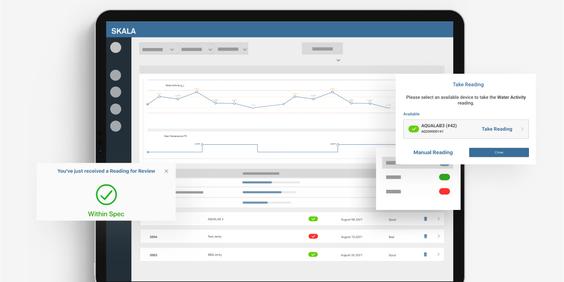a step-by-step breakdown
How SKALA works

There's nothing else like SKALA. Since major innovations always need explanation, here's ours – a step-by-step breakdown of how SKALA shows up in the real world.

Install and onboard
First, a small team of expert engineers and PhD-level scientists will come to your site for a brief visit.
They'll link SKALA to your production equipment and process tracking devices, allowing SKALA to record process data and create complete, pristine, automatic batch records.
SKALA works whether your control parameter is dwell time, belt speed, oven temperature, steam settings, or anything else. Installation is quick, contained, and minimally invasive.
While there, the team will also answer questions, train and onboard anyone who needs to be involved.
Automate batch records
Once the system is linked, you'll immediately have access to batch record analysis dashboards for each of your products.
From then on, every time you take a process measurement like temperature, relative humidity, water activity, moisture content, or anything else, it's written permanently to the batch record. The clear, easy-to-read, real-time graphs and results are accessible from any authorized smart device.


Train the artificial intelligence
Now it's time to teach SKALA's artificial intelligence how to think for itself.
Each time the drying process is completed, the machine learning model in SKALA will predict moisture levels for that batch. Technicians will measure the same metrics from batch samples and enter them into SKALA. SKALA compares the two measurements and adjusts its predictions to match.
From now on, each new batch improves the predictive capability of the SKALA's algorithm. Soon, SKALA will begin to alert operators when drying processes should be stopped to achieve target moistures.
This process usually reduces the standard deviation of batch moisture content by about 50% within two or three months.
Let it run – and reap the benefits
The more SKALA learns, the less technician supervision it needs, and the more benefit it provides.
Each day, SKALA will analyze past data and current inputs (like production environment and incoming ingredient moisture levels) to determine – and then automatically adjust to — the ideal machine settings to produce the highest quality and greatest yield from each batch.
All data, past and present, gets written to the same easily referenced database of batch records – a permanent asset to your company.


Achieve return on investment
SKALA-enabled facilities generally achieve return on investment before SKALA's artificial intelligence even reaches complete maturity — within four months on average.
During those months (and afterward, as needed), you’ll have anytime access to our client success managers to make sure adoption goes smoothly.
Humble your auditors
When audit time comes, there's no need to spend hours checking facts and rooting through three-ring binders. With the SKALA Lab module, all of the data SKALA automatically collects is available in real time to document compliance. It’s all audit-ready, traceable, searchable, and instantly accessible on any smart device.


The food manufacturer’s complete guide to water activity
Education Guide
For a cheap ingredient, water can cause a lot of expensive problems in the food industry. The best way to understand water in your product is by learning about water activity (aw).

The beginner's guide to measuring yield and waste in food manufacturing
Education Guide
Understanding and eliminating waste is a powerful way to boost profits – but where to start? We recommend exploring these seven common methods for waste reduction.
